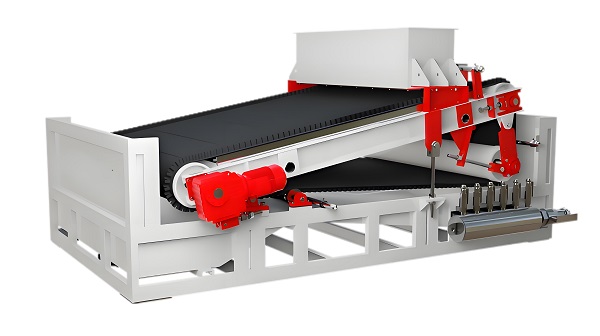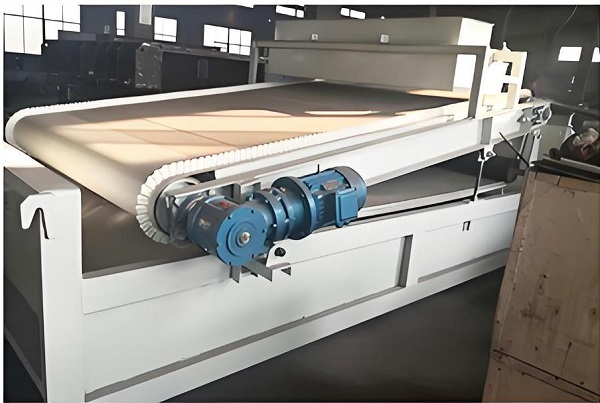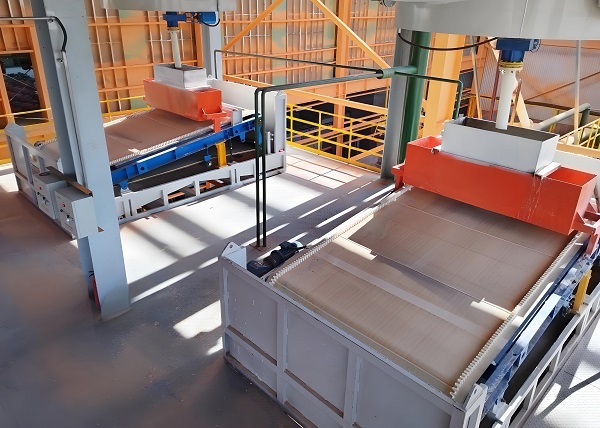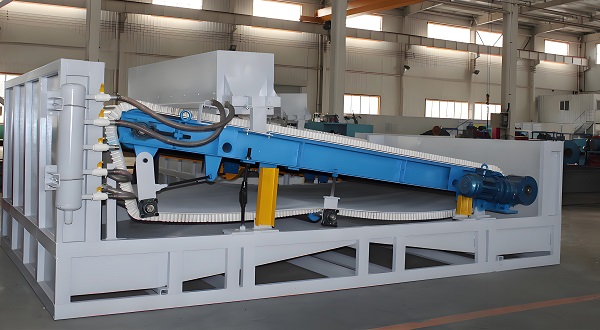Preface: Magnetic separator, also known as magnetic separator or magnetic iron remover, is a common equipment in industrial production. It is mainly used to remove ferromagnetic impurities in materials to ensure the continuity of production lines and product quality. The following introduces the concept, classification, working principle and precautions of magnetic separators.

Flat plate magnetic separator
A. Overview of magnetic separator:
Magnetic separator, also known as iron remover, is a type of instrument that can generate strong magnetic field attraction. It will definitely remove the iron-containing magnetic impurities in the material to ensure and ensure the safe and normal operation of motors, grinders and other mineral processing equipment in the operating system. In addition, it will definitely effectively reduce the occurrence of accidents caused by large and long iron pieces scratching the operating belt, and can also significantly improve the quality of raw materials.
Electromagnetic iron remover is a kind of magnetic iron removal device that uses a scraper embedded in the car engine leather to clean the powder or block non-magnetic materials. It is generally installed at the head or middle of the belt conveyor. The strong permanent magnetic field formed by turning on the power will attract the iron pieces mixed in the material and then throw them out by the unloading belt, successfully achieving the result of automatic cleaning.

Flat plate magnetic separator
B. Classification of magnetic separation equipment
The magnetic system of magnetic separation equipment can be divided into two categories according to the configuration of magnetic poles: open magnetic system and closed magnetic system. The so-called open magnetic system refers to a magnetic system in which magnetic poles are arranged adjacent to each other on the same side and there is no induced ferromagnetic medium between the magnetic poles. According to the arrangement characteristics of magnetic poles, open magnetic systems can be divided into three types: planar magnetic system, cylindrical magnetic system and tower magnetic system. The pole arrangement of the planar magnetic system is a plane and is mostly used in belt magnetic separation equipment and experimental equipment. The pole arrangement of the cylindrical magnetic system is an arc surface, which is often used in drum-type weak magnetic field magnetic separators. The arrangement surface of the tower magnetic system is a tower shape, which is mainly used in permanent magnetic desludging tanks.
1. The common characteristics of the open magnetic system are that the magnetic poles are arranged alternately on the same side, the magnetic system pole pitch is large, the magnetic flux passes through the air gap between the magnetic poles for a long distance, and the leakage magnetic flux is large, so the magnetic field strength of the separation space is low, so this magnetic system can only be used in weak magnetic field magnetic separation equipment for separating strong magnetic ores. However, the sorting space of the open magnetic system is relatively large, it can process coarse-grade ores, and the processing capacity of the equipment is relatively large.
2. The closed magnetic system refers to the relative configuration of magnetic poles, and a special ferromagnetic medium (such as a toothed round silver, a toothed plate, a sphere, a filament, and a net, etc.) is installed in the middle of the magnetic poles. In this magnetic system, the air gap between the magnetic poles is small, the distance of the magnetic flux through the air gap is short, the magnetic resistance of the magnetic circuit is small, and the leakage flux is small, so the magnetic field intensity in the sorting space is large. Because the ferromagnetic medium has a special shape and a large magnetic field gradient, the magnetic field force is large, which is suitable for strong magnetic field magnetic separation equipment for sorting weak magnetic ores. However, this magnetic system is only used to process fine-grained ores, and the production capacity is generally low.

Flat plate magnetic separator
C. Working principle of magnetic separator
The magnetic separator is a screening device used to remove iron powder and other screening equipment in recycled powder particles. After the slurry flows into the trough through the feed box, the ore particles enter the feed area of the trough in a loose state under the action of the water flow of the feed water pipe. Under the action of the magnetic field, the magnetic ore particles gather to form "magnetic clusters" or "magnetic chains". The "magnetic clusters" or "magnetic chains" are affected by the magnetic force in the ore pulp and move toward the magnetic poles and are adsorbed on the cylinder. Since the polarity of the magnetic poles is arranged alternately along the rotation direction of the cylinder and is fixed during operation, the "magnetic clusters" or "magnetic chains" produce magnetic stirring due to the alternation of magnetic poles when rotating with the cylinder. Non-magnetic minerals such as gangue mixed in the "magnetic clusters" or "magnetic chains" fall off during the turning, and the "magnetic clusters" or "magnetic lotuses" that are finally adsorbed on the surface of the cylinder are the concentrates. Magnetic separators are widely used in resource recovery, wood industry, mining industry, kiln industry, chemical industry, food and other factories. They are suitable for wet magnetic separation of materials such as magnetite, pyrrhotite, roasted ore, ilmenite, etc. with a particle size of less than 3mm. They are also used for iron removal operations of materials such as coal, non-metallic minerals, and building materials. It is one of the most widely used and highly versatile machines in the industry.

Flat plate magnetic separator
D. Correct and reasonable steps for replacing magnets in magnetic separators
Magnets are the core components of iron removers, and their performance directly affects the iron removal effect. Correct and reasonable replacement of magnets is essential to maintain the normal operation of iron removers. The following introduces the steps and functions of replacing magnets:
1. Necessity of replacing magnets
During the use of magnets, magnets will gradually saturate and lose magnetism due to the continuous adsorption of ferromagnetic impurities, thus affecting the iron removal effect. In addition, magnets may also be damaged by improper operation, material impact and other factors. Therefore, regular inspection and replacement of magnets are the key to maintaining the performance of iron removers.
2. Steps for replacing magnets
a. Stoppage inspection: Before replacing the magnet, first stop the operation of the iron remover and check the condition of the magnet. Confirm whether the magnet needs to be replaced and the number of replacements.
b. Prepare tools and materials: Prepare the required tools and materials, such as new magnets, screwdrivers, wrenches, etc.
c. Disassemble the old magnet: Use tools such as screwdrivers and wrenches to remove the old magnet from the iron remover. Pay attention to avoid damaging other parts of the iron remover during the disassembly process.
d. Install new magnets: Install the new magnets on the iron remover according to the position of the old magnets. During installation, ensure that the position and direction of the magnets are correct to avoid affecting the iron removal effect.
e. Test and adjust: After installation, start the iron remover for testing. Observe the iron removal effect and adjust the position and height of the magnets if necessary to achieve the best iron removal effect.
Technical parameters of plate magnetic separator:
Model | Magnetic selection size mm | Processing volume T/H | Feeding concentration% | High magnetic field strength GS | Sorting granularity mm | Power kw |
ZCMS-520 | 500X2000 | 3 | 20-25 | 9000-18000 | ≤2 | 1.1 |
ZCMS-620 | 600X2000 | 5 | 20-25 | 9000-18000 | ≤2 | 1.5 |
ZCMS-820 | 800X2000 | 10 | 20-25 | 9000-18000 | ≤2 | 2.2 |
ZCMS-1020 | 1000X2000 | 15 | 20-25 | 9000-18000 | ≤2 | 3.0 |
ZCMS-1220 | 1200X2000 | 20 | 20-25 | 9000-18000 | ≤2 | 4.0 |
ZCMS-1520 | 1500X2000 | 25 | 20-25 | 9000-18000 | ≤2 | 5.5 |
ZCMS-1820 | 1800X2000 | 30 | 20-25 | 9000-18000 | ≤2 | 5.5 |
ZCMS-2025 | 2000X2500 | 35 | 20-25 | 9000-18000 | ≤2 | 7.5 |
ZCMS-2530 | 2500X3000 | 40 | 20-25 | 9000-18000 | ≤2 | 7.5 |
E. Precautions for using magnetic separators
1. When replacing magnets, make sure that the iron remover has been completely shut down and follow the relevant safety operating procedures.
2. When removing and installing magnets, be careful to avoid collision and damage.
3. After replacing magnets, be sure to test and adjust to ensure that the performance of the iron remover is in the best condition.
4. Regularly inspect and maintain the iron remover, and promptly detect and replace damaged magnets to ensure the continuity of the production line and product quality.
PS. Correct and reasonable replacement of iron remover magnets is of great significance to maintaining the normal operation of the iron remover and improving production efficiency. By following the above steps and precautions, the magnet replacement process can be ensured to be safe and efficient, providing strong protection for the production and development of the enterprise.
Save Time! Get A Detailed Quotation Quickly.
